Leonardo da Vinci was primarily a scientist later in life, with art and painting very much a sideline – according to the biggest exhibition yet of his groundbreaking anatomical studies.
The Royal Collection is putting on display 87 pages of Leonardo's notebooks packed full of detailed notes and astonishing drawings of bones, organs, vessels and muscles.
The show's curator, Martin Clayton, said his drawings were among the finest depictions of the human body ever created. "People have known Leonardo as the archetypal renaissance man since his death almost 500 years ago, but on the whole people have seen him as a painter who conducted scientific research on the side, almost as some kind of bizarre hobby.
"What this exhibition shows is that Leonardo was primarily a scientist, at least for the latter part of his life, who executed a few paintings on the side."
Leonardo was observing things that had never been observed before – narrowing of the arteries, say, or coronary blockage and cirrhosis of the liver – and he was drawing things that had never been drawn, such as his depiction of the mechanism by which the forearm twists so that our hand can face either up or down. It would be another 200 years before the observation was repeated.
There are extraordinary drawings of cardiovascular systems, for example, and of coitus, and eddies in an animal's aortic sinus.
But the show raises many what-ifs. Leonardo had intended to publish his anatomical studies – which would have been the most important anatomical work ever written – but two things got in the way of him completing them.
One was the untimely plague death of his young collaborator, Marcantonio della Torre, and the other was the Swiss/Venetian invasion of Milan, forcing him out of the city. The studies remained largely unknown for the next 400 years.
What is known is that they were mounted in albums by the sculptor Pompeo Leoni between 1570 and 1590 and these albums made their way into the Royal Collection in the 17th century, possibly during the reign on Charles II. They were then not properly examined until 1900.
So what if he had finished his studies? "We would now regard Leonardo as one of the greatest scientists of the Renaissance and one of the greatest anatomists of all time," said Clayton. "His work would have been the most important work on anatomy ever published."
Because Leonardo's earlier work was not published, Vesalius's Humani Corporis Fabrica from 1543 is considered the first anatomy textbook.
Whether his studies would have led to medical advances is trickier. "It is not until antiseptics and anaesthetics in particular that surgeons could do anything with the knowledge that people gained through dissection," said Clayton.
Leonardo da Vinci: Anatomist is at the Queen's Gallery, Buckingham Palace from 4 May – 7 October
